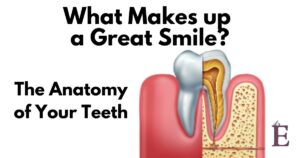What are Great Smiles Made Of?
Learn About the Anatomy of Your Teeth
Some may say that behind every great smile is a great dentist. 😉 BUT, have you ever wondered about the anatomy of your teeth? What exactly are teeth made of? What are the different parts of the tooth? What purpose does each serve to help your teeth function? Learn more about what is LITERALLY behind every great smile, below:
Parts of the Tooth
Let’s get started learning about each part of the tooth — from the inside out. Each tooth has four primary layers; each with a unique and important role.
Pulp. The pulp is the jelly-like, inner center of the tooth which contains the nerves and blood supply necessary to keep our teeth alive. That’s why many consider the pulp to be the most essential part of the tooth. Pulp gives us sensory function, enabling us to sense different temperatures of the food we ingest and also helping us sense pain from trauma or other external stimuli. It is essential to practice good oral hygiene so that the inner tooth pulp remains healthy and can do its job of making dentin (see below!) and keeping your smile healthy and bright.
Dentin. This hard, yellow substance surrounds the pulp and makes up the majority of each tooth. While it may be as hard as bone, it is surprisingly porous and sensitive. Dentin is protected by enamel near the crown and cementum near the tooth roots. It is nourished by the pulp and helps us communicate sensations through the teeth when we enjoy a cool snack or a hot beverage. Do you wonder why teeth can have a yellowish tint? As dentin darkens with age, our teeth tend to become more yellow. That is why teeth whitening has become so popular with many adult dental patients.
Enamel. Known as the “protector” of the tooth, enamel is made of a hard substance known as calcium phosphate that is even tougher than bone! Enamel acts as a strong barrier, giving our teeth the ability to withstand the rigors of chewing and acting as the first line of defense against bacteria that causes cavities. Brushing and flossing is critical to maintaining healthy tooth enamel. However, because enamel has no living cells, it cannot repair itself if it becomes chipped or broken. That is why dentists have perfected cosmetic procedures to help repair damaged tooth enamel and restore healthy smiles.
Cementum. Think of the cementum as cement! It provides a layer of hard tissue that binds the tooth to the gums and jawbone. It is situated under the gum line and covers the outside of the root, securing the tooth firmly in place. It is yellowish and may be softer than dentin and enamel but it certainly provides a vital function by keeping our smiles healthy and intact.
Now that you are familiar with each layer in the anatomy of your teeth, be sure to protect each vital part! It is essential to preserve your teeth and your smile by practicing proper oral hygiene. Brush at least twice a day, floss daily, and see your dentist regularly.
Contact the Dr. E Cosmetic & Family Dentistry team today for your next dental visit! 480-494-2435.


